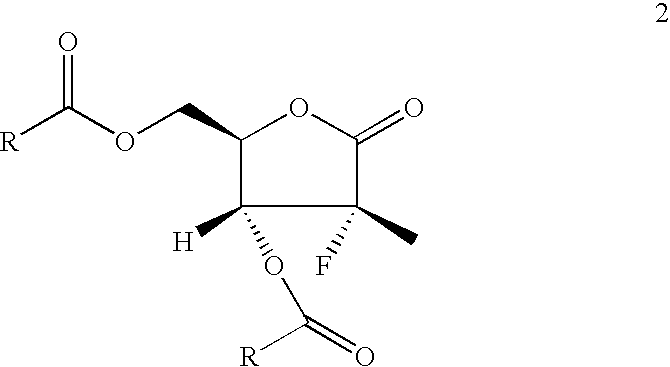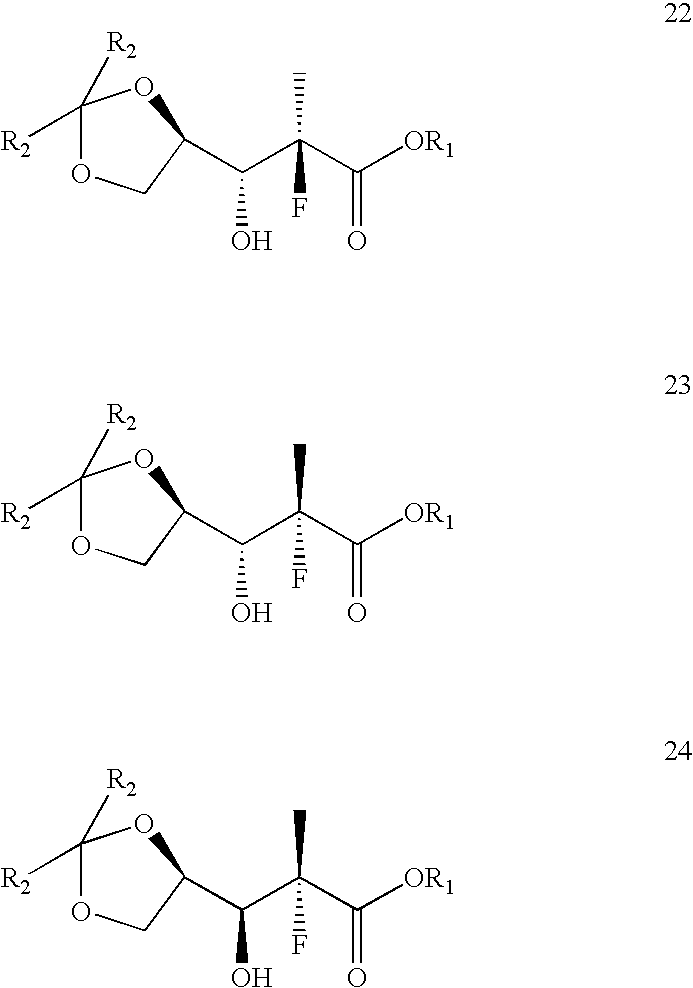Novel process for the preparation of 3,5-di-o-acyl-2-fluoro-2-c-methyl-d-ribono-gamma-lactone
a technology of c-methyl-d-ribono-gamma-lactone and acyl-2-fluoro-2-c-methyl-d-ribono-gamma-lactone, which is applied in the field of new methods for preparing a key intermediate, 3, 5dioacyl2fluoro2cmethyldribono-lactone, can solve the problems of inefficient synthesizing procedures for preparing compound 1
- Summary
- Abstract
- Description
- Claims
- Application Information
AI Technical Summary
Problems solved by technology
Method used
Image
Examples
example 1
Reaction of ethyl 2-fluoropropionate (20, R1=ethyl) with D-glyceraldehyde, 1,2-acetonide (21, R2=methyl)
[0070]
[0071]A dry, clean, 2L, 4-neck round bottom flask, equipped with a mechanic stirrer, a thermo couple, a nitrogen inlet, and an addition funnel, was charged with 266 g of anhydrous tetrahydrofuran (THF) and 38.1 g of diisopropylamine. The mixture was stirred and cooled to 4Cl solution. The mixture was slowly warmed to ambient temperature and transferred to a separatory funnel. The aqueous phase was separated and extracted with 2×132 g=264 g of dichloromethane. The organic phases were combined, dried over MgSO4, filtered, and concentrated to give 58 g crude aldol product as a thick oil. A gas chromatogram showed the oil contained 12.2% of 24, 43.4% of 22, and 35.2% of 23.
example 2
Reaction of ethyl 2-fluoropropionate (20, R1=ethyl) with D-glyceraldehyde, 1,2-pentanonide (21, R2=ethyl)
[0072]
[0073]A dry, clean, 4-neck round bottom flask, equipped with a mechanic stirrer, a thermo couple, a nitrogen inlet, and an addition funnel, was charged with 20 mL of anhydrous THF and 1.8 g of diisopropylamine. The mixture was stirred and cooled to 4Cl solution. The mixture was slowly warmed to ambient temperature and transferred to a separatory funnel. The aqueous phase was separated and extracted with 2×10 mL=20 mL of dichloromethane. The organic phases were combined, dried over MgSO4, filtered, and concentrated to give 3 g crude aldol product as a thick oil. A gas chromatogram showed the oil contained 8.2% of 24, 36.5% of 22, and 30.8% of 23.
example 3
Reaction of n-butyl 2-fluoropropionate (20, R1=n-butyl) with D-glyceraldehyde, 1,2-acetonide (21, R2=methyl)
[0074]
[0075]A dry, clean, 4-neck round bottom flask, equipped with a mechanic stirrer, a thermo couple, a nitrogen inlet, and an addition funnel, was charged with 100 mL of anhydrous toluene and 10 g of diisopropylamine. The mixture was stirred and cooled to <−75° C. To the solution was slowly charged 54 mL of 1.6 M MeLi solution in ethyl ether while maintaining the batch temperature below −55° C. After the addition the mixture was stirred at approximately −75° C. for 30 minutes. To this mixture was then slowly added 11 g of n-butyl 2-fluoropropionate 20 while maintaining the batch temperature below −70° C. The mixture was stirred at −76° C. for 30 minutes and a solution of 8 g freshly distilled D-glyceraldehyde, 1,2-acetonide 21 in 50 mL of anhydrous toluene was slowly added while maintaining batch temperature below −74° C. After the addition the mixture was stirred for appro...
PUM
 Login to View More
Login to View More Abstract
Description
Claims
Application Information
 Login to View More
Login to View More - R&D
- Intellectual Property
- Life Sciences
- Materials
- Tech Scout
- Unparalleled Data Quality
- Higher Quality Content
- 60% Fewer Hallucinations
Browse by: Latest US Patents, China's latest patents, Technical Efficacy Thesaurus, Application Domain, Technology Topic, Popular Technical Reports.
© 2025 PatSnap. All rights reserved.Legal|Privacy policy|Modern Slavery Act Transparency Statement|Sitemap|About US| Contact US: help@patsnap.com



